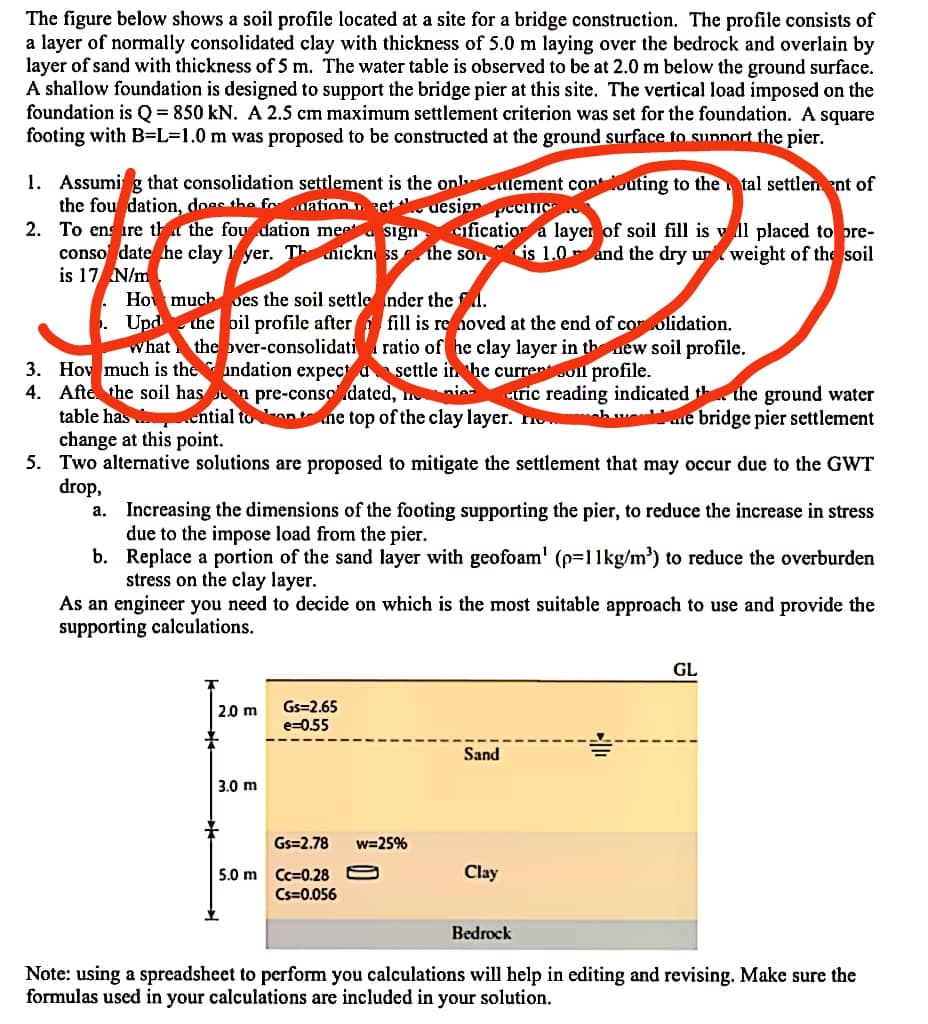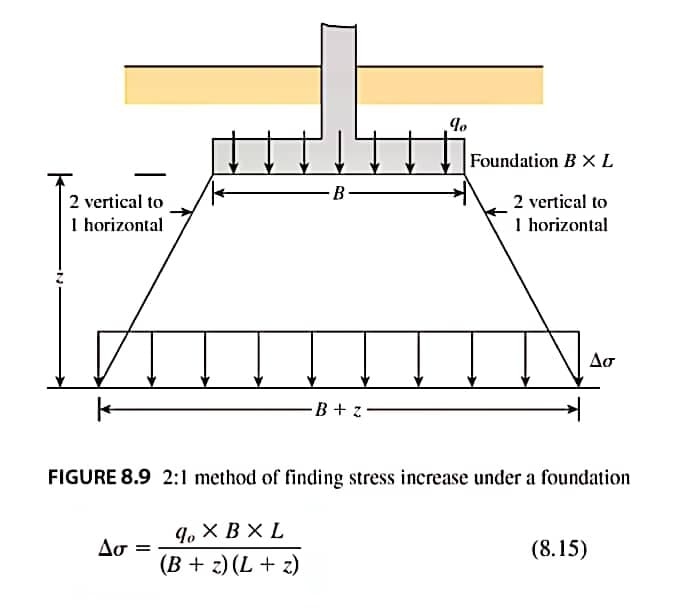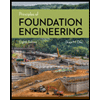The figure below shows a soil profile located at a site for a bridge construction. The profile consists of a layer of normally consolidated clay with thickness of 5.0 m laying over the bedrock and overlain by layer of sand with thickness of 5 m. The water table is observed to be at 2.0 m below the ground surface. A shallow foundation is designed to support the bridge pier at this site. The vertical load imposed on the foundation is Q= 850 kN. A 2.5 cm maximum settlement criterion was set for the foundation. A square footing with B=L=1.0 m was proposed to be constructed at the ground surface to supnort the pier. 1. Assumi g that consolidation settlement is the onlclement conouting to the tal settlen ent of the fou dation, doas the fo ation zet uesignpecie 2. To ensire ta the fou dation mee sign conso date he clay 1 yer. Th ulickn ss the son is 1.0r and the dry ur weight of the soil is 17 N/m ification a layer of soil fill is v ll placed to pre- Ho much oes the soil settle nder the fl. Upd the oil profile after i fill is re noved at the end of cor olidation. what the over-consolidatiratio of he clay layer in thew soil profile. 3. Hov much is the andation expect u settle in he currensoll profile. 4. Afte the soil has n pre-conso dated, n table has ential toonne top of the clay layer. h change at this point. Two altemative solutions are proposed to mitigate the settlement that may occur due to the GWT drop, a. Increasing the dimensions of the footing supporting the pier, to reduce the increase in stress nie uric reading indicated ththe ground water e bridge pier settlement due to the impose load from the pier. b. Replace a portion of the sand layer with geofoam' (p=11kg/m³) to reduce the overburden stress on the clay layer. As an engineer you need to decide on which is the most suitable approach to use and provide the supporting calculations. GL 2.0 m Gs=2.65 e=0.55 Sand 3.0 m Gs=2.78 w=25% Clay 5.0 m Cc=0.28 9 Cs=0.056 Bedrock Note: using a spreadsheet to perform you calculations will help in editing and revising. Make sure the formulas used in your calculations are included in your solution.
The figure below shows a soil profile located at a site for a bridge construction. The profile consists of a layer of normally consolidated clay with thickness of 5.0 m laying over the bedrock and overlain by layer of sand with thickness of 5 m. The water table is observed to be at 2.0 m below the ground surface. A shallow foundation is designed to support the bridge pier at this site. The vertical load imposed on the foundation is Q= 850 kN. A 2.5 cm maximum settlement criterion was set for the foundation. A square footing with B=L=1.0 m was proposed to be constructed at the ground surface to supnort the pier. 1. Assumi g that consolidation settlement is the onlclement conouting to the tal settlen ent of the fou dation, doas the fo ation zet uesignpecie 2. To ensire ta the fou dation mee sign conso date he clay 1 yer. Th ulickn ss the son is 1.0r and the dry ur weight of the soil is 17 N/m ification a layer of soil fill is v ll placed to pre- Ho much oes the soil settle nder the fl. Upd the oil profile after i fill is re noved at the end of cor olidation. what the over-consolidatiratio of he clay layer in thew soil profile. 3. Hov much is the andation expect u settle in he currensoll profile. 4. Afte the soil has n pre-conso dated, n table has ential toonne top of the clay layer. h change at this point. Two altemative solutions are proposed to mitigate the settlement that may occur due to the GWT drop, a. Increasing the dimensions of the footing supporting the pier, to reduce the increase in stress nie uric reading indicated ththe ground water e bridge pier settlement due to the impose load from the pier. b. Replace a portion of the sand layer with geofoam' (p=11kg/m³) to reduce the overburden stress on the clay layer. As an engineer you need to decide on which is the most suitable approach to use and provide the supporting calculations. GL 2.0 m Gs=2.65 e=0.55 Sand 3.0 m Gs=2.78 w=25% Clay 5.0 m Cc=0.28 9 Cs=0.056 Bedrock Note: using a spreadsheet to perform you calculations will help in editing and revising. Make sure the formulas used in your calculations are included in your solution.
Fundamentals of Geotechnical Engineering (MindTap Course List)
5th Edition
ISBN:9781305635180
Author:Braja M. Das, Nagaratnam Sivakugan
Publisher:Braja M. Das, Nagaratnam Sivakugan
Chapter17: Settlement Of Shallow Foundations
Section: Chapter Questions
Problem 17.11P
Related questions
Question
Please solve only part 5

Transcribed Image Text:The figure below shows a soil profile located at a site for a bridge construction. The profile consists of
a layer of normally consolidated clay with thickness of 5.0 m laying over the bedrock and overlain by
layer of sand with thickness of 5 m. The water table is observed to be at 2.0 m below the ground surface.
A shallow foundation is designed to support the bridge pier at this site. The vertical load imposed on the
foundation is Q = 850 kN. A 2.5 cm maximum settlement criterion was set for the foundation. A square
footing with B=L=1.0 m was proposed to be constructed at the ground surface to sunnort the pier.
1. Assumi g that consolidation settlement is the onl ulement conouting to the tal settlenent of
the fou dation, does the fo ation et uesignpeciie
2. To ens ire tha the fou dation meea sign
conso date he clay yer. Thalickn ss the son is 1.0r and the dry ur weight of the soil
is 17 N/m
ification a layer of soil fill is y ll placed to pre-
Ho much es the soil settle nder the f1.
Updthe pil profile after fill is re noved at the end of corolidation.
what the over-consolidati ratio of he clay layer in thew soil profile.
3. Hov much is the undation expect d settle in hec currenoll profile.
4. Afte the soil has n pre-conso dated, n
table has ential to nne top of the clay layer. n
change at this point.
5. Two alternative solution
drop,
a. Increasing the dimensions of the footing supporting the pier, to reduce the increase in stress
nie
uric reading indicated th the ground water
e bridge pier settlement
are proposed to mitigate the settlement that may occur due to the GWT
due to the impose load from the pier.
b. Replace a portion of the sand layer with geofoam' (p=11kg/m³) to reduce the overburden
stress on the clay layer.
As an engineer you need to decide on which is the most suitable approach to use and provide the
supporting calculations.
GL
Gs=2.65
e=0.55
2.0 m
Sand
3.0 m
Gs=2.78
w=25%
5.0 m Cc=0.28
Clay
Cs=0.056
Bedrock
Note: using a spreadsheet to perform you calculations will help in editing and revising. Make sure the
formulas used in your calculations are included in your solution.

Transcribed Image Text:Foundation B X L
B
2 vertical to
2 vertical to
I horizontal
I horizontal
Ao
B+ z•
FIGURE 8.9 2:1 method of finding stress increase under a foundation
9, × B × L
(B + z) (L + z)
Ao =
(8.15)
Expert Solution
This question has been solved!
Explore an expertly crafted, step-by-step solution for a thorough understanding of key concepts.
Step by step
Solved in 2 steps with 2 images

Knowledge Booster
Learn more about
Need a deep-dive on the concept behind this application? Look no further. Learn more about this topic, civil-engineering and related others by exploring similar questions and additional content below.Recommended textbooks for you

Fundamentals of Geotechnical Engineering (MindTap…
Civil Engineering
ISBN:
9781305635180
Author:
Braja M. Das, Nagaratnam Sivakugan
Publisher:
Cengage Learning

Principles of Geotechnical Engineering (MindTap C…
Civil Engineering
ISBN:
9781305970939
Author:
Braja M. Das, Khaled Sobhan
Publisher:
Cengage Learning

Principles of Foundation Engineering (MindTap Cou…
Civil Engineering
ISBN:
9781305081550
Author:
Braja M. Das
Publisher:
Cengage Learning

Fundamentals of Geotechnical Engineering (MindTap…
Civil Engineering
ISBN:
9781305635180
Author:
Braja M. Das, Nagaratnam Sivakugan
Publisher:
Cengage Learning

Principles of Geotechnical Engineering (MindTap C…
Civil Engineering
ISBN:
9781305970939
Author:
Braja M. Das, Khaled Sobhan
Publisher:
Cengage Learning

Principles of Foundation Engineering (MindTap Cou…
Civil Engineering
ISBN:
9781305081550
Author:
Braja M. Das
Publisher:
Cengage Learning

Principles of Foundation Engineering (MindTap Cou…
Civil Engineering
ISBN:
9781337705028
Author:
Braja M. Das, Nagaratnam Sivakugan
Publisher:
Cengage Learning